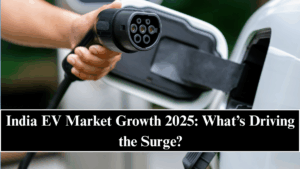India’s electric vehicle (EV) revolution is no longer a distant dream—it’s a 2025 reality. The country’s EV market has surged exponentially, driven by government incentives, battery-swapping infrastructure, affordable electric scooters, and domestic manufacturing. What began as an urban mobility experiment is now transforming India’s entire automotive ecosystem, from two-wheelers to commercial fleets.

Government Policies Fueling EV Adoption
India’s rapid EV growth can be directly attributed to strong policy intervention. The government’s FAME-II (Faster Adoption and Manufacturing of Electric Vehicles) scheme continues to provide crucial subsidies for both consumers and manufacturers.
Key initiatives include:
-
GST reduction on EVs from 12% to 5%.
-
Income tax rebates of up to ₹1.5 lakh on EV loan interest.
-
Production Linked Incentive (PLI) schemes for advanced chemistry cell (ACC) batteries and EV components.
-
State-level incentives in Maharashtra, Delhi, Tamil Nadu, and Gujarat offering additional purchase discounts and road tax exemptions.
Together, these measures have reduced upfront costs and accelerated India’s transition to cleaner mobility.
The Rise of Battery Swapping Infrastructure
One of the major bottlenecks for EV adoption has been long charging times. In 2025, India has aggressively deployed battery swapping networks, led by companies like SUN Mobility, Ola Electric, and Bounce Infinity.
Battery swapping offers a simple model — rather than waiting for a recharge, drivers exchange their depleted batteries for charged ones in under 3 minutes.
This has been a game changer for:
-
Commercial fleets like e-rickshaws and delivery vehicles.
-
Two-wheelers and three-wheelers where cost and time efficiency matter most.
-
Urban transport systems, enabling seamless operation without downtime.
Government support for standardized battery swapping policies ensures compatibility across brands, further boosting convenience.
Local Manufacturing and “Make in India” Momentum
India’s EV ecosystem is increasingly self-reliant. Under the “Make in India” initiative, domestic manufacturers are building batteries, motors, and control units locally, reducing import dependence.
Key developments include:
-
Tata Motors leading the four-wheeler EV segment with Nexon EV and Punch EV.
-
Ola Electric and Ather Energy dominating the e-scooter market with 95% local components.
-
Mahindra scaling up commercial EV manufacturing for urban logistics.
-
Hyundai, MG, and BYD investing in new Indian EV production hubs.
This domestic production push has lowered costs, increased job opportunities, and positioned India as a potential EV export hub for Asia and Africa.
Market Segmentation: Two-Wheelers Lead the Charge
While global EV growth is centered around cars, India’s revolution is powered by two-wheelers. In 2025, over 70% of electric vehicles sold in India are scooters or bikes. Brands like TVS iQube, Hero Vida, and Ampere are making EVs mainstream among middle-class buyers.
The four-wheeler market is catching up fast, led by Tata, Hyundai, and Mahindra, while electric buses are transforming public transport in cities like Delhi, Mumbai, and Bengaluru.
According to industry data, India’s EV market is expected to reach ₹80,000 crore ($10 billion) by the end of 2025, with annual growth of over 45%.
Investment and Startup Ecosystem Boom
India’s EV boom has also sparked massive investment in startups and charging tech firms.
-
Venture capital funding in EV and clean-tech startups crossed $2.3 billion in 2025 alone.
-
Battery recycling startups such as Lohum and Attero are solving the sustainability puzzle.
-
Charging network companies like ChargeZone and Statiq are expanding across national highways.
This wave of innovation is creating a robust EV ecosystem—one that spans energy, mobility, and infrastructure.
Challenges and Road Ahead
Despite the progress, India’s EV sector still faces hurdles:
-
Limited charging coverage in rural and Tier-2 cities.
-
High battery costs, though they’re expected to drop by 20–25% in the next two years.
-
Consumer awareness and concerns about battery life.
However, with continuous policy backing, domestic R&D, and increasing competition, these obstacles are being addressed faster than ever.
The Road to 2030: A Fully Electrified Vision
India’s vision for 2030 is bold — 30% of all new vehicle sales to be electric. With EV adoption now spanning personal, public, and commercial segments, that target no longer feels out of reach.
By 2025, India has already laid the foundation with:
-
Battery swapping at scale
-
Nationwide fast-charging corridors
-
100% localized EV production goals
As global automakers look toward sustainability, India’s EV story has emerged as one of the most dynamic and fastest-growing markets in the world.
FAQs
What is driving India’s EV market growth in 2025?
Government incentives, local manufacturing, battery swapping, and public awareness have collectively accelerated India’s EV growth.
Which EV segment is growing fastest in India?
Electric two-wheelers dominate with over 70% of the market share, followed by electric cars and buses.
What is the role of battery swapping in India’s EV ecosystem?
Battery swapping allows drivers to replace batteries instantly, cutting charging time to under 3 minutes — ideal for fleets and urban vehicles.
Which automakers are leading India’s EV revolution?
Tata Motors, Ola Electric, Ather Energy, TVS, and Mahindra are leading domestic production and sales in 2025.
What is India’s EV market projection by 2025?
India’s EV market is valued at around ₹80,000 crore ($10 billion) with an annual growth rate exceeding 45%.
Click here to know more.
